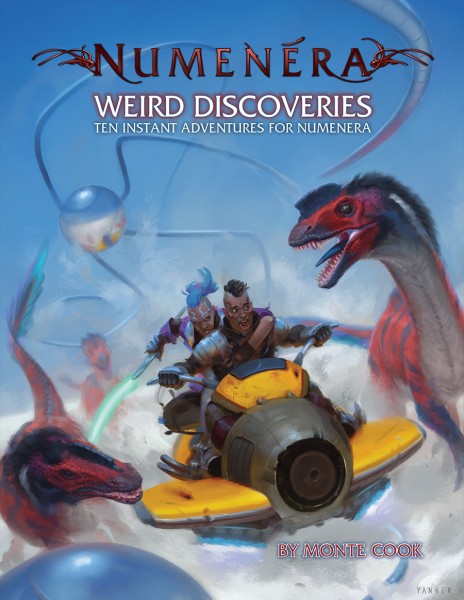Monte Cook Games has been talking a lot recently about their Instant Adventures. You can even purchase Weird Discoveries: Ten Instant Adventures for Numenera.
 The idea of an instant adventure is you have just enough prepared to let you improv your way to a good game session. Instead of an item, clue, or other plot point attached to place (under the rug is a hidden map), plot points are fluid and can be placed in whatever scene fits your session's pacing. GUMSHOE GMs will note the similarities with floating core clues.
The idea of an instant adventure is you have just enough prepared to let you improv your way to a good game session. Instead of an item, clue, or other plot point attached to place (under the rug is a hidden map), plot points are fluid and can be placed in whatever scene fits your session's pacing. GUMSHOE GMs will note the similarities with floating core clues.
So, what can we steal to make our own instant adventure? In this post I'll look at the building blocks of an instant adventure. In the next, I'll make my own.
Instant adventures can work not just in Numenera, but in any system.
First you have a list of bullet points about what is really going on. The characters won't have a clue about this information at the start of the session. For example, an ancient machine has awoken and is capturing people and "improving" them in tragic ways.
Then a hook (starting point): The guide the PCs are counting on has vanished, as have a number of people.
And and ending (wrap-up): The PCs stop the machine and maybe have rescued a few of the people, including the guide.
Next you come up with two to four floating plot points, or keys. A key can be a clue, knowledge, evidence (say in a murder mystery), an item, or something that "summons" a creature. A person who knows where the vanished people went. A device that will fix a sparking sphere. An item that makes the machine think the PCs don't need improvement.
Next, seven to twelve nodes. These are people or places. You can sketch a graph or map that shows all the nodes and which keys might be at any node. Any key could show up at a number of nodes. In play, the GM picks one based on the session, pacing, and what has hooked the player's interest. The players really really like this stupid rock in front of the glowing house? Then it's not a stupid rock, it's a key!
People can have information or items. They can sometimes be opponents. Places can have items, clues, weird numenera, and/or creatures.
Note which key(s) might be with this node. Nodes can point to other nodes. Some nodes can be bottlenecks, the PCs must get past this node to continue the session.
Example node: A deep well with a sparking sphere at the bottom. Next to the sphere is a door that leads to the rest of the session, but won't open until the PCs repair the sphere. If the item that makes the machine think they don't need improvement is here, the PCs must remove it from the sphere and take it with them. Past the door is the dancing reptile woman.
You can tie your instant adventure into your campaign as extra credit if you with.
Then run and enjoy. Let the keys show up when it feels right for the pacing and whatever lunacy your players are up to.
Next time I'll build a tiny instant adventure.

